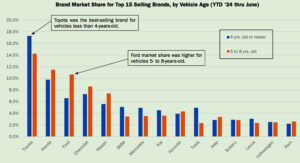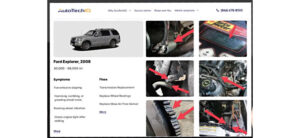Starting in 2029, automakers must make automatic emergency braking standard in cars and light trucks
Washington, D.C.—The U.S. Department of Transportation’s National Highway Traffic Safety Administration (NHTSA) finalized a new Federal Motor Vehicle Safety Standard this week that will make automatic emergency braking (AEB), including pedestrian AEB, standard on all passenger cars and light trucks by September 2029. This safety standard is expected to significantly reduce rear-end and pedestrian crashes.
Automakers are expected to be able to meet the September 2029 mark as many have already committed to AEB. A 2016 commitment to AEB was brokered by the Insurance Institute for Highway Safety and the National Highway Traffic Safety Administration (NHTSA) with OEMs. In it, the automakers pledged to equip at least 95 percent of their cars and trucks up to 8,500 pounds with the technology by the production year that ended Aug. 31, 2023.
As reported in December 2023, 20 participating automakers fulfilled the voluntary pledge to equip nearly all the light vehicles they produce for the U.S. market with automatic emergency braking (AEB).
Five new manufacturers installed AEB on more than 95 percent of the light vehicles they produced between Sept. 1, 2022, and Aug. 31, 2023, to meet the deadline set in the agreement. General Motors, Jaguar Land Rover, Maserati and Porsche all dramatically increased the proportion of their vehicles equipped with the technology to meet the target. Kia, which was already close last year, also crossed the finish line.
Audi, BMW, Ford/Lincoln, Honda/Acura, Hyundai/Genesis, Mazda, Mercedes-Benz, Mitsubishi, Nissan/Infiniti, Stellantis, Subaru, Tesla, Toyota/Lexus, Volkswagen and Volvo fulfilled the voluntary commitment in previous years.
AEB systems use sensors to detect when a vehicle is close to crashing into a vehicle or pedestrian in front and automatically applies the brakes if the driver has not. Pedestrian AEB technology will detect a pedestrian in both daylight and in darker conditions at night.
The new standard requires all cars be able to stop and avoid contact with a vehicle in front of them up to 62 miles per hour and that the systems must detect pedestrians in both daylight and darkness. In addition, the standard requires that the system apply the brakes automatically up to 90 mph when a collision with a lead vehicle is imminent, and up to 45 mph when a pedestrian is detected.
This final rule applies to nearly all U.S. light vehicles (gross vehicle weight rating of 10,000 pounds or less). A Final Regulatory Impact Analysis that presents the benefits and costs associated with the standard is included in the Final Rule.









Comments are closed.